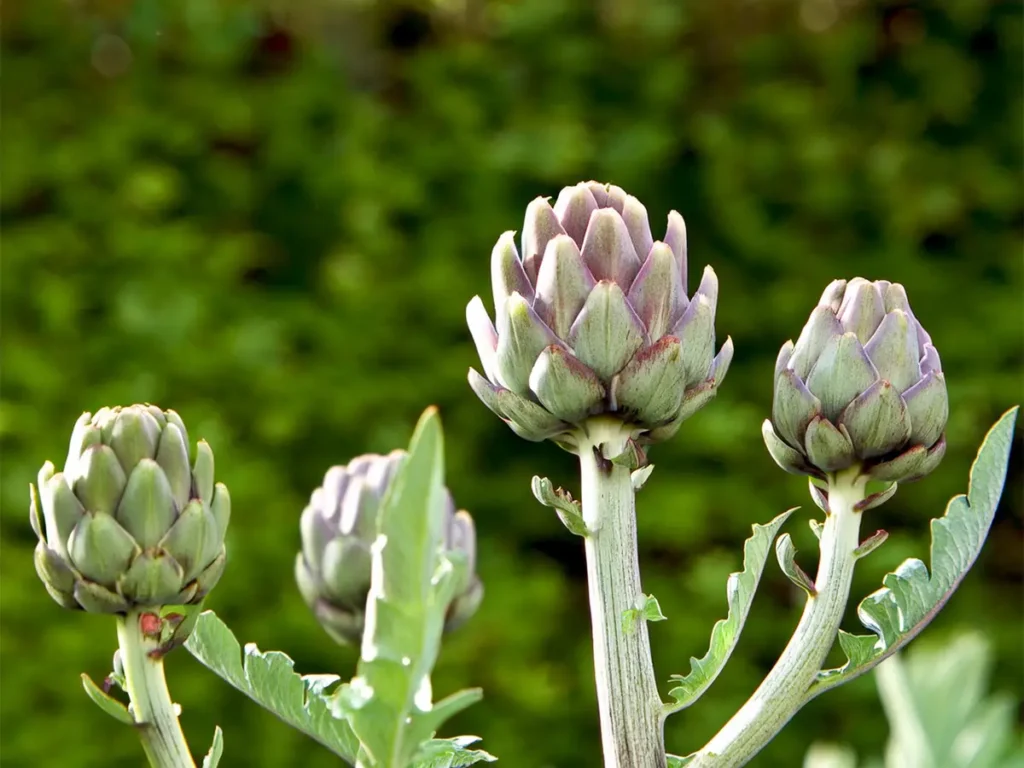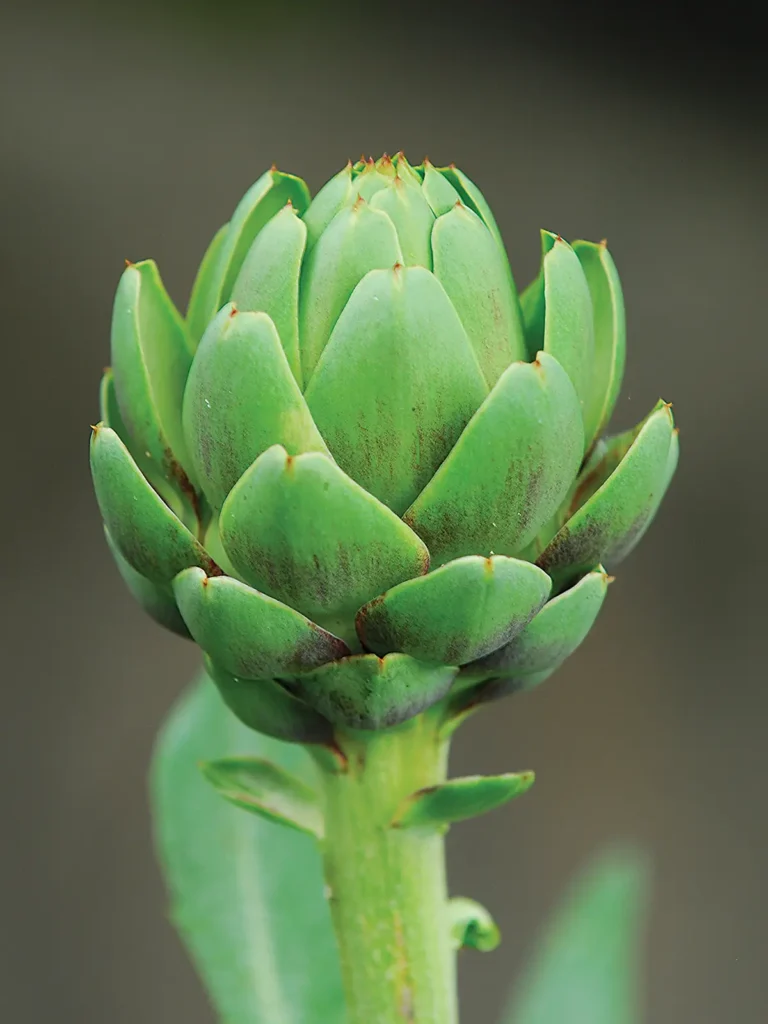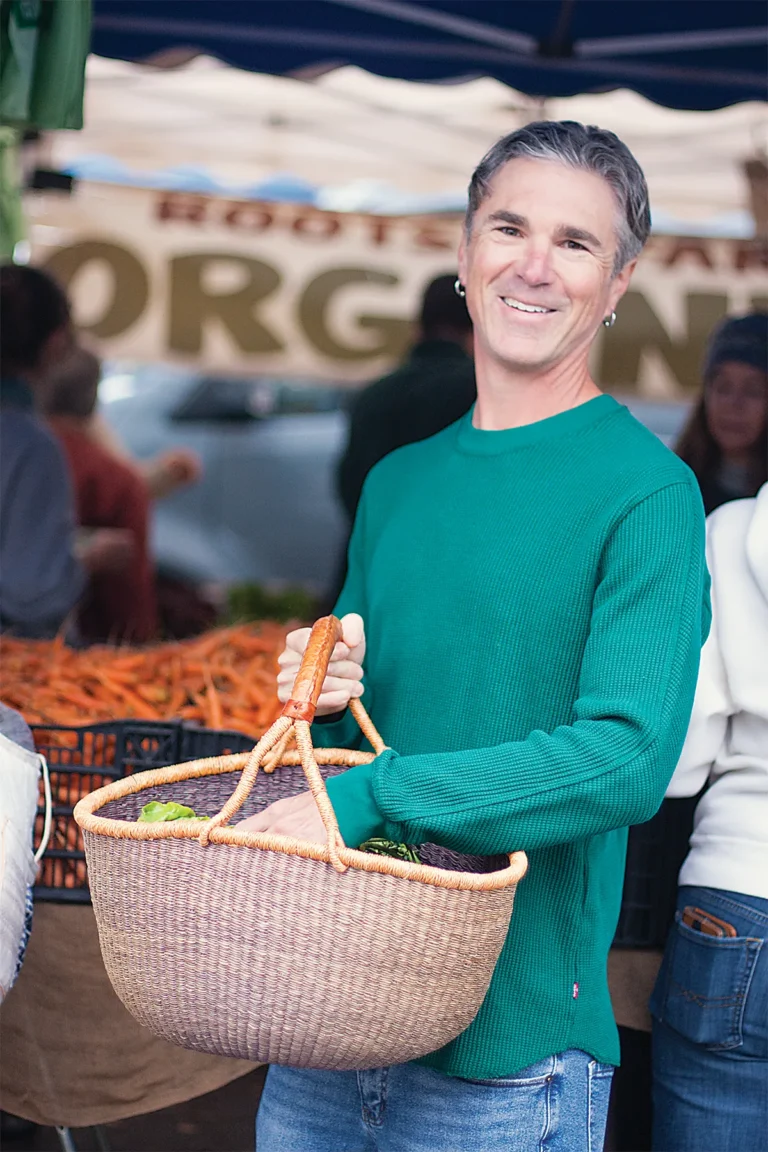Okey-Dokey Artichokey

Spectacular thistle or delectable dish? Artichokes are a little of both. If you don’t harvest their tasty, tender buds in spring, the prehistoric-looking plants will produce thready, iridescent lavender flowers the size of softballs
by summer.
Botanically speaking, artichokes are indeed a perennial thistle (Cynara cardunculus var. scolymus). They are also a member of the sunflower family, native to the Mediterranean and ideal for growing on the Central Coast, where they thrive with the same cool, moist winters and warm, dry summers as their homeland. Frost-free pockets along the coast are most desirable. The entire U.S. commercial crop comes from California, with the bulk from Castroville. Locally, just west of Lompoc, with its year-round coastal fog and chilly ocean breezes, Baroda Farms grows artichokes on 250 acres and sells more than 100,000 cartons a year.
But because artichokes bear their main crop in spring, you can grow them in warmer inland areas as well by taking steps to mitigate summer heat and winter freezes.
Even if you never harvest a single bud (perish the thought), they are still fabulous landscape plants, with bold, architectural silhouettes, silvery deeply serrated leaves and gorgeous purple flowers.
Getting Started
Artichokes are easiest from bare-root, with nurseries offering dormant divisions through February. If you miss that window, young plants are often available in spring.
Buy local so you can inspect the roots, which should be plump, moist and smell earthy. Fresh tips may be emerging from the rough, chunky mass.
Ideally you will have dug a hole before bringing home your new bare-root plant, to avoid letting it sit, exposed to the world, and dry out.
Must-haves in the garden include loose soil, fertility and excellent drainage.
Artichokes may live five or six years and send down surprisingly deep roots—to two feet or more. Loose, sandy or loamy soil helps those roots dive deep. Drainage is key. Plants may not survive winter if forced to endure cold puddles for days on end.
Keep them away from other permanent plants, including shrubs, vines and trees. Artichokes don’t like to compete for water, nutrients or space. Know that a single plant can span five feet and grow three to four feet tall. They are true behemoths—some might say in a charming, rustic or sculptural sort of way.
But you only need one plant, as artichokes do not require a companion for pollination. Although you’ll make quite a statement if you set out a full row.
In the Garden
There are no second chances with planting a perennial edible: Good soil prep is essential.
Choose a spot that receives a minimum of six hours of daily sunlight by early spring. Away from the coast, morning sun is best, with some afternoon shade.

Mark a circle at least three feet wide. Loosen the soil down 12 to 18 inches, then mix through the entire profile a third to half that volume of fine-textured compost, well-aged manure or other organic material.
Within the top six inches or so, add a slow-release fertilizer containing phosphorous for root development and flowering; potassium for overall vigor; and mycorrhizae to help the artichoke more efficiently take up nutrients and moisture.
If gophers are an issue, use a large gopher basket. Bury the root chunk with only the growing tips above ground. Shape a watering basin at least three feet wide. My theory is that no basin is too big, because artichokes get huge at their bases and quickly obliterate anything of a more standard size.
Fill the basin several times to really soak the soil. Then water once a week if winter rains don’t comply. Keep your plant well-watered while buds form.
After a few good-sized leaves appear, start applying light doses of nitrogen monthly. Or apply earthworm castings, fish emulsion, kelp, weekly drenches of compost tea or some other natural, slow-release product to provide nutrients, trace elements and the like. You may also need to bait for ants, snails, slugs or earwigs.
What to Expect
Artichokes often take a year to swing into full production, so don’t be discouraged if your first-year plant doesn’t get enormous or bear scads of luscious buds and flowers.
A few smaller buds may appear by fall. But the first real harvest won’t likely begin until next spring, once the roots have bulked out and started sending up stems in earnest.
A mature plant produces about 10 stems, with a succession of four to five flowers on each. Harvest the buds while still tightly closed. Slice them off with a few inches of stem, which is edible, too.
That first flush of buds will be your largest chokes. Those appearing farther down will be smaller but just as flavorful.
After harvest, whack down the foliage almost to the ground. Stop watering to initiate dormancy.
About a month later, begin watering again for a fall crop. The buds will be smaller and possibly cone-shaped, but still delicious.
You might let some buds go to flower. They’re great for sustaining wild bees and other pollinators, and are beautiful in the garden and in bouquets.
However, if you garden in summer heat, do let any remaining spring-time buds go to flower. You won’t be getting that bonus fall crop because your artichoke will go dormant when temperatures reach the mid-80s. Cut down the withered foliage and stop watering until fall. Before any danger of frost, cut any remaining foliage to about a foot, bend it over the crown, then mulch with about 12 inches of straw, chopped leaves or other loose material over winter. Come spring, uncover the crown to greet a new season.
After a few years, look for new plants at your artichoke’s base. After the spring or fall harvest, gently cut and lift out the newcomers, taking care not to damage too many roots. Prep new holes and start anew.






